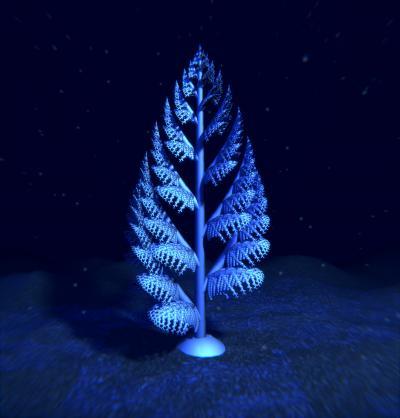Rangeomorphs were unlike any modern organism, which has made it difficult to determine how they fed, grew or reproduced, and therefore difficult to link them to any particular modern group.
They looked like plants but evidence points to the fact that rangeomorphs were actually some of the earliest animals.
Starting 541 million years ago, the conditions in the oceans changed quickly with the start of the Cambrian Explosion – a period of rapid evolution when most major animal groups first emerge in the fossil record and competition for nutrients increased dramatically.

These are not plants, though they look like it. This paleontological reconstruction of rangeomorph fronds from the Ediacaran Period shows species are from the deep-marine Avalon Assemblage (approximately 575-560 million year ago) known from fossil sites in Canada and the UK, and some are also known from later Ediacaran assemblages. These reconstructions were built using computer models of rangeomorph growth and development. Image courtesy of Jennifer Hoyal Cuthill (University of Cambridge).
"We know that rangeomorphs lived too deep in the ocean for them to get their energy through photosynthesis as plants do," said Dr Jennifer Hoyal Cuthill of Cambridge's Department of Earth Sciences, who led the research. "It's more likely that they absorbed nutrients directly from the sea water through the surface of their body. It would be difficult in the modern world for such large animals to survive only on dissolved nutrients."
"The oceans during the Ediacaran period were more like a weak soup – full of nutrients such as organic carbon, whereas today suspended food particles are swiftly harvested by a myriad of animals," said co-author Professor Simon Conway Morris.
This is an animation of the growth and development of the extinct rangeomorph species Beothukis mistakenis, which lived during the Ediacaran Period from approximately 575 to 555 million years ago. Video courtesy of Jennifer Hoyal Cuthill, University of Cambridge.
Rangeomorphs have often been considered a 'failed experiment' of evolution as they died out so quickly once the Cambrian Explosion began in earnest, but this new analysis shows just how successful they once were.
Rangeomorphs almost completely filled the space surrounding them, with a massive total surface area. This made them very efficient feeders that were able to extract the maximum amount of nutrients from the ocean water.
"These creatures were remarkably well-adapted to their environment, as the oceans at the time were high in nutrients and low in competition," said Dr Hoyal Cuthill. "Mathematically speaking, they filled their space in a nearly perfect way."

Image courtesy of Jennifer Hoyal Cuthill, University of Cambridge.
Dr. Hoyal Cuthill examined rangeomorph fossils from a number of locations worldwide, and used them to make the first computer reconstructions of the development and three-dimensional structure of these organisms, showing just how well-suited they were to their Ediacaran environment.
As the Cambrian Explosion began however, the rangeomorphs became 'sitting ducks', as they had no known means of defence from predators which were starting to evolve, and the changing chemical composition of the ocean meant that they could no longer get the nutrients they required to feed.
"As the Cambrian began, these Ediacaran specialists could no longer survive, and nothing quite like them has been seen again," said Dr. Hoyal Cuthill.





Comments